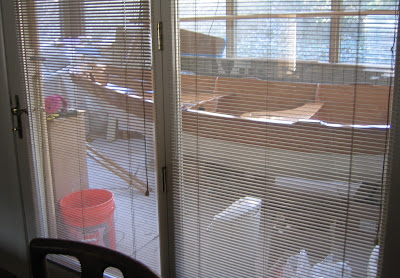Phew! No spring fling this little winter project would be!
Also: I am happy to report that the ice on Lake Arthur has vanished. Instead, hundreds of Buffleheads and Mergansers are frolicking on the lake. A great opportunity to do some birding of early migrants, don't you think? This coming week does not look promising but I am keeping my fingers crossed for next weekend.
I had fiddled around with rigging the down-haul but now have a nice arrangement with a double purchase. I may set up a cam cleat on the mast step but that can wait.
It did take me quite a while to figure out an elegant method of attaching the sail to the boom and yard.
John Harris, the designer of the PMD (and owner of CLC), had suggested that these spars would probably be attached in a semi-permanent way much like the sail of a sunfish.
 In response to my question, he suggested using the reefing knot where the two ends would be capped with a half-hitch thereby preventing the relatively loose knot to get undone. With an 1/8" line this obviously will work well, and look pretty tidy.
In response to my question, he suggested using the reefing knot where the two ends would be capped with a half-hitch thereby preventing the relatively loose knot to get undone. With an 1/8" line this obviously will work well, and look pretty tidy.However, after messing around with the lug sail and spars in my basement for some time, I found that it was impossible to flake the sail nicely with both spars attached.
I wanted therefore to be able to detach sail from yard relatively easily. This would allow me to flake the sail along the still-attached boom and then roll it around the yard for sail-kindly storage. With that objective in mind, the proposed knot would not be convenient. Eventually I came up with a solution that looks quite neat, can easily be undone and seemed practical.
I started with 20" pieces of 1/8" Dacron cord.
After cutting the pieces, I dipped the ends in Liquid Rope Whipping.
I then folded the line in half and tied some whipping twine as though it were the end of a rope.
The result was a loop in the middle of the line which could be opened and closed by slipping the twine up and down like a quasi-zipper.
The two ends were then threaded together through the noose...
...and knotted with a twin half hitch.
The Liquid Rope Whipping kept the two ends together quite nicely.
Voila! All that needed to be done now was to "zip up" and pull the double half-hitch toward the noose.
The resulting ring could now easily be opened and closed and slipped through the cringle in the sail and around the spar.
* * *
As it turns out, I really only need to open about five rings on the yard - after that, the yard simply slips out of the remaining cord rings.
In part I had complicated my task a bit since I stitched leather around the parts of boom and yard which intersect with the mast of this balanced lug rig. More on that and other lug rig specific items in a future blog.
* * *
 |
| Broad-reaching up my driveway - ready for some real action! |
Ready to launch!



















